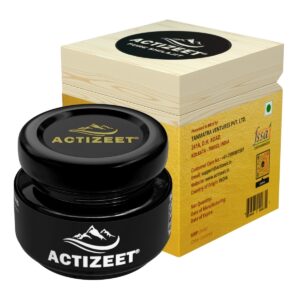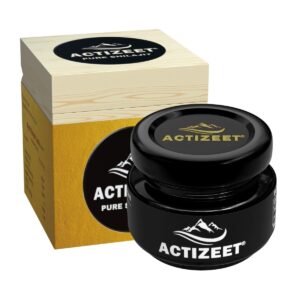The method of formation of shilajit is through the long-term decomposition of microorganisms. The organic content of shilajit is 60–80%, and the mineral content is 15-20%. Scientific studies on shilajit show that it is safe to consume shilajit and its resulting benefits.
Shilajit, a unique substance with a rich history in traditional medicine, has recently gained attention for its potential health benefits. This blog post aims to provide a comprehensive overview of scientific studies on Shilajit, examining its geological origins, chemical composition, and the evidence supporting its therapeutic properties.
Table of Contents
ToggleWhat is Shilajit?
Shilajit is a dark brown plant-based asphalt; it is classified as a dietary supplement. The Sanskrit word ( śilājatu /shilaras/shilajit) means “the conqueror of rocks. It is also known as “the sweat of the mountain” in Arabia, “the blood of the mountain” in Myanmar, and “the rock” in Tibet and Mongolia. In Europe, they are called mumiyo, mumie, moomio, and Mumijo, its Latin name is Asphaltum punjabinum. But the most common name is Shilajit.
In Indian traditional medicine, it is considered to be an excellent medicine for treating wounds. It is effective in treating fractures and anti-inflammatory and anti-ageing wrinkles. Therefore, shilajit was widely used in traditional medicine in Bhutan, Russia, Tibet, India, Kazakhstan, and other countries.
Chemical Composition Of Shilajit
Generally, the organic content of shilajit is about 60–80%, and the mineral content is 15-20%. The main components are 60%–80% humic and fulvic acid in iron-containing plant sources.
Therefore, Shilajit is rich in mineral salts, amino acids, fulvic acid, and other nutrients, while other organic components are: benzoic acid, hippuric acid, fatty acids (myristic acid, stearic acid, oleic acid, petroselinic acid, linoleic acid, lauric acid, saturated fatty acids), ichthyol, lanolin, resins, triterpenes, sterols, aromatic carboxylic acids, amino groups acids, phenolic lipids, 85 kinds of trace minerals (potassium, calcium, and magnesium are the most), latex, albumin, sterols, tea polyphenols, phenolic lipids, dibenzo-α-pyrone (DBP), Selenium, dibenzo-α-pyrone chromoproteins (DCPs), etc.
It can be seen that shilajit has been used for a long time. At the time of the Soviet Union, shilajit exports were also banned because of their preciousness. Also, Read the Full list of shilajit ingredients and composition
Formation Method Of Shilajit
The method of formation of shilajit is through the long-term decomposition of microorganisms, and then the orogenic movement will move these materials together to the mountain, and in the summer period will seep out of the 4000 meters above sea level of the Himalayas or alpine rock crevices, It has good stability and is resistant to corruption and deterioration, and can be stored for a long time.
Shilajit in the Himalayas has a generation time much longer than the orogeny of the Himalayas 100 million years ago. The resulting biologically active lipid
Origin Of Shilajit
Produced in the Himalayas, Tibet Plateau, Caucasus Mountains, Altai Mountains, Siberian Mountains, and other mountainous areas with an altitude of 1000–5000 meters. Currently, it is found in different regions, such as Bhutan, China, Europe, America, Tibet, India, Russia, and the Caucasus region.
Shilajit is obtained from the mudstones of the Himalayas. The local harvest needs to be obtained by manually climbing the rock wall. After removing impurities such as sand, stir it in clean water and let it stand for some time, then take the supernatant, heat it, and concentrate it into a paste. It has good stability, can withstand low temperatures is not easy to spoil, and can be stored for a long time.
Classification Of Pure Shilajit
Shilajit also has different colours and grades according to the difference of the metal types, such as red for more gold ( Sauvarna Shilajit ), white for silver ( Rajat Shilajit ), and blue for copper ( Tamra Shilajit ), iron-containing is black ( Lauha Shilajit Shilajit ), among which gold-containing black Shilajit is the rarest and considered the best curative effect. In nature, iron-containing Shilajit is used most in traditional medicine.
Is it safe to consume Shilajit?
Scientific studies show that it is safe to consume shilajit and its resulting benefits.
- To understand whether the immediate consumption of a small amount or a large amount of shilajit will cause acute toxicity in the body, in the 2012 Asian Pacific Journal of Tropical Biomedicine, Velmurugan et al. studied 91 consecutive days of feeding shilajit to normal house Rats. It was found that they had no changes in behaviour and no death or illness and measured the iron content and weight of their internal organs. In terms of organ weight, there was no significant difference from the control group.
- Sidney J. Stohs reported in the journal Phytotherapy Research in 2014 that high-dose shilajit did not produce acute toxicity in rats while feeding rats shilajit for 90 days, no negative effects on the liver, kidney, hematopoietic function, or behaviour of these mice were found.
- In 2013, in the Journal of Veterinary Science & Animal Husbandry, Fleck reported that dogs having a problem with arthritis were fed with medicine containing pure shilajit in the morning and evening for 150 consecutive days. On the 90th day, the dog’s pain index improved significantly. In the past 150 days, the behavioural ability of the dog has been greatly improved, such as being able to run, jump, and even climb stairs. There is no significant change in body weight, heartbeat, body temperature, etc. in the process.
To Check Systemic Toxicity
In a human trial in “Ancient Science of Life” in 2003, people between 16 and 30 years old were given shilajit every day for 45 consecutive days, and their heartbeat, blood pressure, weight, blood composition, liver, and kidney function were observed. There were no significant changes found after 45 days of consuming shilajit.
In Phytotherapy Research in 2014, Sidney J. Stohs also mentioned that after giving shilajit twice a day to healthy suspects for 90 consecutive days, he did not find any signs of liver, kidney function, vital signs, or blood composition.
U.S. Food Management’s Classification and Related Regulations for Shilajit
In the United States, shilajit is a “dietary supplement” (for related bills, please refer to the Dietary Supplement Health and Education Act (referred to as the DSHEA Act)). In the DSHEA Act, dietary supplements are defined as beneficial to the human body, as they can provide people with insufficient nutrition and help prevent diseases.
According to the provisions of this Act, the industry only needs to declare the safety approval method of dietary supplements to the US FDA before the product goes on the market, without approval. Also, dietary supplements must be marked “The claim of this product has not been evaluated by the FDA, and it is not used to diagnose, treat, cure, or prevent any disease.”
European Countries’ Regulations On Shilajit
According to the analysis and survey report of the “Centre for the Promotion of Imports from Developing Countries” (Centre for the Promotion of Imports from Developing Countries, Netherlands) on the European market of shilajit, shilajit is classified as a “food supplement” in European countries. “(Food supplement).
The United Kingdom On Consuming Shilajit
Shilajit was judged by the British government as a “non-medical product; the tar-like substance formed from the decomposition of plants is not regarded as a herbal medicine in the British drug regulations. It was used in Ayurveda.
There is no production source for shilajit in the UK, so shilajit products sold in the UK also have to rely on imports. From the perspective of British food supplements and import management methods, shilajit is a quasi-edible food supplement in the UK.
Modern Medical Perspective
The most important functional organics in Shilajit are humic acid and fulvic acid. According to the records of Ayurveda in India, Tibetan Medicine Classics, Kazakh Medicine, and clinical research in modern medicine, Shilajit is currently used in anti-inflammatory treatments and to treat ulcers.
The traditional medical dosage is 0.3 g per day for 20–25 days, which can treat digestive ulcers. Also, if the wound burns, shilajit can prevent wound inflammation, accelerate healing, and reduce pain. Experiments have shown that 100 mg/kg of shilajit twice a day can effectively improve the gastric ulcer in rats. also, if the dose is 50 mg/kg, it can effectively reduce the edema caused by inflammation in rats.
Diabetes
Shilajit has the function of scavenging free radicals. Animal experiments have proved that feeding rats 100 mg/kg shilajit for 28 days can effectively reduce the value of high blood sugar. Therefore, it was found in the study that shilajit can prevent type 2 diabetes. Also, read Shilajit for diabetes
Anti-allergy
In animal anti-allergic experiments, it was found that the fulvic acid extracted from Shilajit, fed to mice at 10 mg/kg for two weeks, can effectively reduce the effect of mast cells that cause allergic reactions, thereby achieving anti-allergic
Immunomodulatory
Researchers have found that feeding rats 25–50 mg/kg of Shilajit for 5 days can effectively reduce serotonin and 5-hydroxy indole acetic acid, as well as increase dopamine in the brain, which is believed to be effective in increasing body fluids. The immune response.
Promotes Metabolism
Studies have shown that if athletes take 0.3–0.6 g of shilajit daily for about 2-2.5 months (stop taking twice at intervals for about 30–40 days), the synthesis speed of different organs can be increased. Protein and nucleic acid synthesis accelerate the metabolic efficiency of the liver and promote the absorption of calcium, magnesium, and phosphorus minerals by the bone.
Stimulate Somatic Cell Regeneration
After 20 days of bone treatment, 50 patients took 0.6 g of Shilajit every day, which proved to be effective in promoting bone cell regeneration.
Treats Neuralgia
Many researchers have pointed out that in the treatment of neuralgia, shilajit is combined with other medicinal materials to form a compound medicinal material, which also has a significant effect on patients.
Reduces Cholesterol
Experiments have proved that after consuming 2 grams of Shilajit every day for 45 days, the number of triglycerides, high-density fat, and cholesterol in the blood has been significantly reduced, which effectively increases the antioxidant strength in the blood and can significantly reduce cholesterol.
Conclusion
As we navigate the intricate landscape of scientific studies on Shilajit, it’s evident that this ancient substance holds significant promise. From antioxidant properties to potential cognitive benefits and anti-inflammatory effects, Shilajit’s diverse array of compounds provides a rich tapestry for researchers to explore. While more studies are needed to fully unlock its therapeutic potential, the existing research encourages us to appreciate Shilajit not only for its historical significance but also for its exciting possibilities in the realm of modern medicine. As we await further scientific discoveries, the journey into the world of Shilajit continues to captivate the curiosity of both researchers and health enthusiasts alike.
Buy Pure Shilajit
-
Himalayan Shilajit, Pure shilajit, Shilajit, SHUDDH SURYA TAPI SHILAJIT
Rated 4.74 out of 5₹4,950.00Original price was: ₹4,950.00.₹3,950.00Current price is: ₹3,950.00. Incl. GST ADD TO CART Buy Now -
Himalayan Shilajit, Pure shilajit, Shilajit, SHUDDH SURYA TAPI SHILAJIT
Rated 4.78 out of 5₹9,900.00Original price was: ₹9,900.00.₹6,450.00Current price is: ₹6,450.00. Incl. GST ADD TO CART Buy Now -
Himalayan Shilajit, Pure shilajit, Shilajit, SHUDDH SURYA TAPI SHILAJIT
Rated 4.74 out of 5₹3,450.00Original price was: ₹3,450.00.₹2,450.00Current price is: ₹2,450.00. Incl. GST ADD TO CART Buy Now -
Himalayan Shilajit, Pure shilajit, Shilajit, SHUDDH SURYA TAPI SHILAJIT
Rated 4.81 out of 5₹8,400.00Original price was: ₹8,400.00.₹5,450.00Current price is: ₹5,450.00. Incl. GST ADD TO CART Buy Now
Related posts:
- Original shilajit | Benefits, Dosage, Products, Prices, Reviews
- Shilajit: Is It The Answer To Low Sperm Count?
- Can Shilajit Be Taken Empty Stomach?
- Shilajit Benefits for Men : An Exclusive Look
- Shilajit Supplement: Benefits, Uses and More
- Shilajit for Libido: The Natural Solution for Sexual Health and Vitality
- Benefits of Taking Shilajit Before Workout
- What is Actizeet Shilajit?








